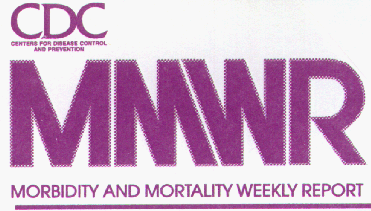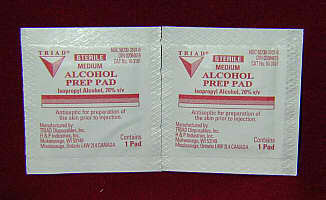
The CDC (Centers for Disease Control and Prevention) released more information about the FDA (Food and Drug Administration) recall[1] of contaminated Triad alcohol wipes and two of the related infections in patients at one hospital in Colorado.
When one patient became infected with B. cereus in October 2010 and another became infected the following month, TCH (The Children’s Hospital in Aurora, Colorado) investigated.
–
The subsequent TCH investigation into the two cases focused on the following three single-use, disposable items used in the treatment of both patients: 1) sterile syringes prefilled with sterile saline solution, 2) sterile applicators packaged with a 2% chlorhexidine gluconate/70% alcohol solution for skin preparation, and 3) pledgets packaged with 70% isopropyl alcohol (alcohol prep pads [APPs]).[2]
While it is possible that there was another source of the infections, or another source that contributed to the infections, these three products became the focus of the investigation.
The sterile syringes would generally be the last of the three to be used.
Whether the the alcohol prep pads are used before the chlorhexidine/alcohol is used, after the chlorhexidine/alcohol is used, or before and after the chlorhexidine/alcohol is used can be critically important.
Do we clean the skin with the alcohol prep pad, then make it sterile with chlorhexidine/alcohol?
If you look at the images above, you will see that one of the boxes of Triad Alcohol Prep Pads is labelled as sterile, while the other does not appear to mention anything about being sterile.
–
What does the use of the alcohol prep pad add to the sterility of the site, if used before the chlorhexidine/alcohol combination?
This may help to cut down on the dirt and germs on the skin. If the use of alcohol prep pads contaminates the site with B. cereus at this point, the chlorhexidine/alcohol combination should kill the B. cereus.
What does the use of the alcohol prep pad add to the sterility of the site, if used after the chlorhexidine/alcohol combination?
At this point, the chlorhexidine and alcohol should no longer be present on the site. Neither is desirable inside the body. While 2% chlorhexidine does not sound like much, especially when we see that there is 70% alcohol, the percentages are misleading. Chlorhexidine is used in mouthwash at 0.12%, but the skin preparation at 2% is a concentration more than 16 times stronger. If the chlorhexidine were more concentrated than 2% that would be too toxic.
Alcohol is very effective at killing some bacteria, but B. cereus is not eliminated by alcohol.
If the chlorhexidine and alcohol are no longer present on the skin, they will do nothing to prevent the contamination of the site by any of the many methods of contamination:
Touching the site with a gloved finger (unless the glove is sterile)
Touching the site with a finger after tearing off the finger of the glove to allow for a better feel.
Wiping the site with an alcohol prep pad.
Coughing, sneezing, drooling, bleeding, or adding other of our bodily fluids to the site.
After any of these, or any other breach of our mini sterile field, we should sterilize the site all over again.
We can act as if we do not understand the germ theory of disease, or we can use our understanding of germ theory to better protect our patients.
Violating the mini sterile field, by any of the methods I described, and not sterilizing it again demonstrates a lack of understanding of the ways we can infect patients with bacteria by our actions.
As an analogy, we can do a great job of eliminating mice from a home, but if we bring our own mice back in, we have defeated all of the things we did to create a mouse-free environment. For the mouse lovers, we can trap the mice and release them someplace far enough away that they will not re-enact The Incredible Journey.
After any of these actions, that can best be described as contamination, we need to use the chlorhexidine/alcohol to make the site sterile again.
In other words, what we do before using the chlorhexidine/alcohol is not very important. What we do after using the chlorhexidine/alcohol is very important.
–
If we don’t strictly observe sterile procedure, most of the time we will probably get away with it. Is that because the infections are generally managed by the immune system or they are not traced back to the actual source? There is also a lack of understanding of Koch’s postulates.
Koch’s postulates are:
1. The microorganism must be found in abundance in all organisms suffering from the disease, but should not be found in healthy organisms.2. The microorganism must be isolated from a diseased organism and grown in pure culture.
3. The cultured microorganism should cause disease when introduced into a healthy organism.
4. The microorganism must be reisolated from the inoculated, diseased experimental host and identified as being identical to the original specific causative agent.[3]
Those are Koch’s postulates, but here are the problems associated with them. Most of these were at least partially understood by Koch at the time.
1. Asymptomatic infections do happen. With some diseases, almost all of the infections are asymptomatic (e.g. polio – 99% of infections are asymptomatic).
2. Not everything can be grown in pure culture (e.g. viruses).
3. As with #1, there can be cases of the germ existing in the patient without other signs of infection. The immune system (natural or enhanced by vaccination) can do a great job at killing germs that otherwise would progress to infection. Co-morbidities may predispose patients to infection.
4. Evolution occurs because truly identical replication is rare. For example –
Twenty-nine B. cereus isolates, 21 from cultured APPs and eight from TCH patients with positive cultures during May–November 2010, were characterized by pulsed-field gel electrophoresis. Wide diversity was observed among the isolates, and no patient isolates matched APP isolates. Given this diversity and the time lapse between positive patient specimens and subsequent APP sampling, the lack of a match between the two groups was not considered to rule out APPs as the source of the B. cereus isolated from patients.[1]
Even though the B. cereus did not match what was found in the patient, there was no other apparent source for the B. cereus infection.
If the area is cleaned with the chlorhexidine/alcohol combination, then B. cereus infected alcohol wipes are applied to the site, there is little reason to doubt that this will lead to the infection of some patients with B. cereus.
If most patients, who have the same preparation of sterile sites, do not become obviously infected with B. cereus, does that mean that this is an acceptable way to prepare sterile sites?
–
Footnotes:
–
[1] Triad Alcohol Prep Pads, Alcohol Swabs, and Alcohol Swabsticks: Recall Due to Potential Microbial Contamination
Sold by Cardinal Health, PSS Select, VersaPro, Boca/Ultilet, Moore Medical, Walgreens, CVS, Conzellin
[Posted 01/06/2011]
FDA (Food and Drug Administration)
Safety Alert
This has been updated 8 times to include recalls of equipment that has Triad alcohol prep pads packaged with the equipment. The equipment is still sterile, but the sterile alcohol prep pads should not be considered sterile. The sterile alcohol prep pads should not even be considered clean. The alcohol prep pads should be considered contaminated with a very nasty germ – Bacillus cereus.
There was also 1 update where the FDA reminded healthcare professionals about the safe use of non-sterile alcohol prep pads to clean and disinfect the surface of the skin. I wrote about that here.
–
[2] Notes from the Field: Contamination of Alcohol Prep Pads with Bacillus cereus Group and Bacillus Species — Colorado, 2010
Morbidity and Mortality Weekly Report (MMWR)
March 25, 2011 / 60(11);347
Article
–
[3] Koch’s postulates
Wikipedia
Article
.




“But, but, my instructor showed me how to start IV’s. All you have to do is wipe in ‘ever increasing concentric circles with the alcohol wipe’ and you’ll wipe all the germs away. Then go ahead and touch the vein again with your clean gloves if you need so you don’t miss. It’s ok, you already cleaned it.” If it was learned in a state sanctioned para-ja-medic class, it has to be correct, right? right? they wouldn’t dare to teach us anything even attempting to being close to being wrong, would they? Say it ain’t so Rogue, say it ain’t so.
Can’t say, clowns will eat me,
I don’t know if anyone is working on that sarcasm font, but you are making the point that there are people who use sarcasm as their second language, if not their first. 🙂
And I deny any knowledge of fixing the 1919 World Series. 😉